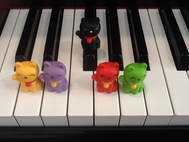
Today, I will be sharing a few different scales that might provide interesting composing opportunities for your students. Ready to have fun with scales? Let’s go!
1. The Major pentatonic scale
Now, I’ve talked a bit about the pentatonic scale and improv HERE. But it is worth repeating, because the pentatonic scale is so easy to harmonize, and it is found in so many different styles of music, from folk music to Impressionist music to jazz!
Beginners can use the black key pentatonic scale to create a melody and hold the damper pedal for instant harmony. Late elementary students can harmonize their melodies using any of the black keys—all of the notes of the pentatonic scale work well with the others.
For intermediate students, create an easy jazz improv by playing the pentatonic scale over seventh chords. For example, play a C major pentatonic scale (C-D-E-G-A) over the chords Cmaj7, Dm7, Em7, and Fmaj7. This will give you a nice, modern jazz sound.
2. The Whole Tone Scale
Do you want to evoke a feeling of magic or outer space? Use the whole tone scale! This scale is made up of all whole steps (hence the name) and is easiest to play as C-D-E-F#-G#-A# (three white keys followed by three black keys).
Just like the pentatonic scale, beginners can use the damper pedal to create instant harmony with the whole tone scale. More advanced students might enjoy harmonizing this scale with major thirds or augmented triads.
3. The Dorian Mode
The Dorian mode can be created by taking a natural minor scale and raising the sixth step—for example, playing the D minor scale with all white keys. To me, the Dorian mode evokes a feeling of medieval or Renaissance music—perhaps because I associate this mode with the song “Scarborough Fair,” which is based on this scale.
Since the Dorian mode is only one note away from the natural minor scale, it can be harmonized easily using chords built on the minor scale—just be sure to use a major IV chord instead of the minor iv usually found in minor keys. Or to play up the medieval feel, experiment with using open fifths to harmonize this scale.
4. The Lydian Mode
The Lydian mode can be created by taking the major scale and raising the fourth step—for example, playing the F major scale with all white keys. The Lydian mode has a playful sound; a couple of pieces based on this scale are “The Simpsons Theme” and “Lost Woods” from the “Legend of Zelda” video game.
Since the Lydian mode is only one note away from the major scale, it can be harmonized with many of the same chords. Just remember to use a major II chord instead of the minor ii usually seen in major keys.
If you would like a more structured way to compose with any of these scales, try using my “Snowflakes” guided composition activity, found HERE. Instead of using a major or minor five note scale as directed on the worksheet, substitute one of the scales I described above. This will help your students to create a really unique, wintry composition—as well as introduce them to some fun, new scale sounds!
What do you think? Do you encourage your students to improvise with scales? What are your favorite non-major or minor scales? Feel free to chime in below!

 RSS Feed
RSS Feed